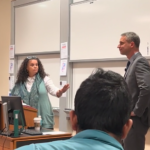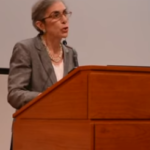Arthur Miller — Communist
On the centenary of his birth, he remains the playwright who made anti-communism a hate crime.
By Paul Kengor – 10.16.15
October 17, 2015 is the centenary of the birth of Arthur Miller, one of the literary left’s shining lights and righteous crusaders against some of liberals’ worst demons: Joe McCarthy, “HUAC,” and, more generally, anti-communism. Yes, anti-communism. As often noted by Harvard’s Richard Pipes and the Hoover Institution’s Robert Conquest, few things have animated liberal animus quite like anti-communism. It’s not that liberals have been pro-communist so much as they are anti–anti-communist. They dislike anti-communists more than they dislike communists. Their preferred demon isn’t Joe Stalin but Joe McCarthy. As James Burnham, the great ex-communist, put it, “for the left, the preferred enemy is always to the right.”
But this does not suffice to describe Arthur Miller. Miller was not only anti-anti-communist; he was pro-communist. More than that, Arthur Miller had been a communist. And that’s something that students in their public schools and in our woeful universities had not and still will not learn as they are spoon-fed Miller’s left-wing morality plays. To the contrary, Miller’s most-lasting works have succeeded in portraying anti-communists as the lowest form of political troglodyte. Chief among those works, the playwright became a hero among the left for The Crucible, his political parable of the alleged excesses of anti-communism, which portrayed accused communists as innocent fighters for truth, justice, and the American way.
And so, the mere suggestion that Arthur Miller was ever a communist himself reflexively sends liberals spinning in circles screaming “McCarthyism,” which itself is a testimony to the effectiveness of the playwright’s propaganda.
Thus, it is to students, suffering prisoners to liberal professors in captive classrooms, that I submit the following history lesson that they will not receive from their $25,000-50,000 per year of “higher” education. And it’s free of charge.
Arthur Miller’s Masses
Arthur Miller was born in New York City in October 1915 to Isidore and Augusta Miller. He would attend the University of Michigan, where he began crafting plays. Though much has been written on Miller, the best recent research on his life, politics, and political-personal double life has been done by Dr. Alan M. Wald, English professor at the University of Michigan. In his excellent, probing 2007 book, Trinity of Passion, published by the University of North Carolina Press, Wald, an honest researcher, shows that Miller had been “a struggling Marxist playwright since the late 1930s.”
A genuine scholar of the left, willing to do the hard digging rather than cite colleagues’ esoteric journal articles, Wald took the time to examine old editions of New Masses, Masses & Mainstream, the Daily Worker, Currents, Jewish Life, the “progressive” PM, and other communist, communist-led, or communist-friendly publications of the era. Wald not only found Miller’s name in those publications, including as a byline, and his plays frequently glowingly reviewed there by comrades, but uncovered a blockbuster: Wald discovered that Miller published in New Masses under the pseudonym of “Matt Wayne” from March 1945 to March 1946.
I likewise scoured those publications, and reported my findings on Miller in my 2010 book, Dupes. They do indeed reveal that Arthur Miller—sometimes even as “Arthur Miller,” when not “Matt Wayne”—was an active participant. Among these publications, two features struck me: Miller’s open participation (under his real name) in a symposium splashed on the cover of New Masses on December 25, 1945 (along with well-known communist screenwriter Albert Maltz); and a gushing interview/profile of a rising young Miller in the April 17, 1946 edition of the Daily Worker, along with an accompanying photograph of the Proletarian playwright. (I include photocopies of all of these things in Dupes.)
Miller’s sentiments in these publications covered a lot of ground, from politics and plays, to culture and war, to anti-Semitism and his search for his Jewish identity. Wald correctly noted that Miller’s political writing in these pages was often “militantly angry.” His tone also reflected the Communist Party USA line and language. In the Daily Worker interview he sat for, Miller explained that “the main fight” in the post-war era was “the fight to raise the living standards of people all over the world and the enemy is imperialism.”
Those Miller contributions stand out. Yet, some of the lesser-noticed items buried inside these publications are likewise illuminating. For instance, Miller in October 1947 was highlighted as a speaker vigorously defending Hollywood screenwriter Howard Fast, a writer for the Daily Worker and New Masses, an editor for Masses & Mainstream, and a novelist who wrote books like The Incredible Tito. Fast would receive the Stalin Peace Prize in 1953. Fast, incidentally, was at the time the most prolific columnist in the communist publication, The Chicago Star, second only to the Star’s founding editor-in-chief, Frank Marshall Davis, a fellow communist who would eventually meet and mentor a young man named Barack Obama in Hawaii in the 1970s.
The admiration between Fast and Miller was mutual. In the Daily Worker, Fast penned a lengthy piece hailing Miller “as the American dramatist of our time.” The Stalin Prize winner even judged that Miller exceeded the infamous Lillian Hellman, a compliment that must have sent the scowling Hellman seething with envy.
Another interesting example of how Miller is found in these publications is seen in the July 3, 1945 issue of New Masses, which, on page 24, offered its readers a special deal: The comrades-turned-capitalists advertised a reduced rate on a one-year subscription to their publication if purchased with a choice book by one of the listed authors. These authors and their works included Volume 23 of The Collected Works of V. I. Lenin; Owen Lattimore’s Solution in Asia; Bertolt Brecht’s The Private Life of the Master Race; Dr. Harry F. Ward’s The Soviet Spirit (Ward was the “progressive” Methodist minister who piously served the ACLU and every communist front-group under the sun); and, among a handful of others, Arthur Miller’s Situation Normal.
Professor Wald notes that New Masses made such offers for no less than three books by Arthur Miller: Situation Normal, Focus, and All My Sons. “Usually the books offered with New Masses subscriptions were by well-known communists,” notes Wald, “it was uncommon to see three by one author.”
That is absolutely right. Arthur Miller, evidently, was a special case. Apparently, Miller’s thinking fell that closely in line with the Marxists at New Masses.
In fact, not only at New Masses: Arthur Miller had eager communist readers literally half-a-world away. No less than Jane Fonda shared her excitement when, upon her propaganda visit to Hanoi in 1972, she “saw Vietnamese actors and actresses perform the second act of Arthur Miller’s play, ‘All My Sons.’” Fonda found this “very moving.” I’m sure she did. And the communist Vietnamese, for that matter, found Miller’s work very moving and very useful in their campaign against America.
Most interesting, all of this Miller work was still well before The Crucible. He was just warming up.
The Crucible: “by far Miller’s best play”
And then, only after all of that, came The Crucible, Miller’s magnus opus. It is his crowning achievement. Ask any product of the public schools. We all had to read The Crucible cover to cover.
What is seldom stated in classroom discussions, however, is that communists loved The Crucible as much as liberals did. The review of The Crucible in the January 28, 1953 issue of the Soviet-funded and directed Daily Worker carried the unequivocal headline, “‘The Crucible,’ Arthur Miller’s Best Play.”
“It is by far Miller’s best play,” began reviewer Harry Raymond. The communist reviewer called it “a case history” of “persecution” and “hysteria” against “innocent men and women sent to the gallows” in Salem, Massachusetts in 1692. But make no mistake, explained Raymond, “It is impossible to view this play honestly without noting the awful parallel courses of two widely separated American persecutions: the Salem witchhunt and the current persecution of Communists and other progressives.” No question about that.
The reviewer further explained: “Like the Salem persecution, the present one is directed by the ruling class of the land, its leaders of government, its judges, and what reactionary clergy they have been able to enlist.” And what of these reactionaries? The atheist Daily Worker was moved to Scripture, inspired to invoke the image of Christ at this sober moment, perhaps for the benefit of its friends on the Religious Left; these reactionaries had “deserted the teachings of Jesus to follow the war god Mars.”
Communists reveled over Arthur Miller’s perceived link between Salem witch-hunters and American anti-communists, and could not hold back their applause, exhorting non-communist liberals to the encore. To that end, the Daily Worker, on the same page of its review, posted an accompanying sidebar on “What Other Critics Said About ‘Crucible.’” There, the Daily Worker led appreciatively with the endorsement of the New York Times reviewer, who dubbed Miller’s play “powerful,” and a “genuine contribution.” “Neither Mr. Miller nor his audiences,” wrote Times reviewer, Brooks Atkinson, in a line repeated and underscored by the Daily Worker, “are unaware of certain similarities between the perversions of justice then and now.”
Whereas Miller’s plays had always received warm reviews by the communist press, this time he was feted by a wider national audience, advanced especially by the political blessing of the venerable New York Times, longtime citadel of towering, numbing naïveté toward communism—and the bible of the elite left.
While Miller no doubt basked in the sunlight of progressive encomiums for his work, the spotlight yielded a double-edged sword. As his popularity with the general public skyrocketed, he also began to be noticed by forces not quite so naïve to the communist threat.
“I see my name here…”
Given this newfound fame and influence, by the mid-1950s, Arthur Miller was called to appear before the House Committee on Un-American Activities. His testimony on June 21, 1956 received tremendous attention. It prompted eye-catcher headlines in the New York Times, such as, “Arthur Miller Admits Helping Communist-Front Groups in ‘40s.” Or, as the Times put it in the lead: “Arthur Miller, playwright, disclosed today a past filled with Communist-front associations.”
To Congress, Miller conceded the numerous pro-communist appeals he had signed and the protests he joined by Red-backed groups. He refused to name names of those who were there with him. Likewise, he would not name people who joined him during the mere four or five times that he said he had attended Communist Party writers’ meetings. Miller also denied that he had ever been under “communist discipline” and would not answer the question of whether he had ever joined the Party.
The most dramatic moment of the hearing came when the House Committee’s lead counsel asked Miller if he once signed an application to join the Communist Party. As Miller dissembled, the counsel presented the exact five-digit application number on the Communist Party application form that contained Miller’s name and address at 18 Schermerhorn Street in New York. Congress went so far as to publish a photocopy of the application card.
That exhibit remains a striking form of evidence. A photocopy is published on page 191 of my book, Dupes. Under the banner “Victory in 1943,” the form states, “APPLICATION FOR MEMBERSHIP” and lists an “A. Miller,” with occupation of “writer” at an address that just happened to be Miller’s own Brooklyn address. The number of the application was 23345. Confronted with this rather compelling evidence, and asked if it indeed proved that he had made an “application for membership in the Communist Party,” Miller curiously told Congress, “I would not affirm that. I have no memory of such thing.”
For a man that the left still hails as nothing short of unsurpassable genius—with the word “brilliant” a standard description—this was a notable and lamentable memory crash.
Does it mean that Miller was once a communist? Well, with that and all else, yes, of course—at the very least ideologically if not officially.
That said, coming up with an actual Party card for Miller has been another task altogether. To my knowledge, no one has found that card.
“Had Miller ever joined the Party?” asks Allan Ryskind in his recent Hollywood Traitors. “HUAC never came up with a card, as they had with each of the Hollywood Ten. But Miller seemed, at the very least, to have come right up to the precipice.” (Ryskind’s presentation suggests that Miller was not just a dedicated comrade but a rather vicious one. When Miller wasn’t telling Congress repeatedly, “I see my name here. I would not deny I might have signed it,” he was blistering ex-communists like Elia Kazan.)
Not that we actually need the card, given that the totality of evidence against Miller is so utterly overwhelming—especially the obviousness that he was at least a small “c” communist if not a formal Party member. But even then, we need not hedge. Alan Wald’s work shows that Miller was surely a Party member at least during the 1945-46 period when he wrote for New Masses as the mysterious “Matt Wayne.” Wald also quotes a damning concession from Miller’s memoirs, Timebends, where (on page 407) Miller allowed for the possibility that “HUAC” lead investigator Richard Arens might have produced a Communist Party membership card: “How to explain that even if he had produced a Party card with my signature on it, I could only have said yes, I had probably felt that way then,” wrote Miller.
How could Miller have imagined Arens producing a card that never existed? Miller surely knew there was a card out there somewhere.
“Communist Stooge”?
Throughout his career of demonizing anti-communists, Arthur Miller kept a lot of things close to the vest. Among them was whether The Crucible was, in plain fact, an allegory about McCarthyism. It obviously was, but Miller was always coy about divulging his total intentions on-the-record.
That elusiveness went on for a long, long time. The conventional take on the play was that it was “a story of the persecution of persons accused of witchcraft in Salem in 1692”—to quote the New York Times in June 1956. That was how Arthur Miller himself had publicly explained it. Typically, reviewers and Miller alike stopped short of explicitly linking Salem to the House Committee on Un-American Activities.
Yet, the world had always surmised, and many teachers have long taught, that The Crucible was obviously about the anti-communist “witch-hunts” in the 1950s, even as Miller did not openly concede that intention. Indeed, Miller’s refusal to transparently discuss his motivations has long caused much confusion. I personally know of two cases from completely different ideological perspectives, both within Western Pennsylvania, where I reside: One is a liberal high-school history teacher who for decades has taught his students that The Crucible was a scathing parable of McCarthyism. The other, a conservative, is a stage director who works for a university, and who was asked to stage The Crucible; she did her research, and subsequently could not find clear attestation from Miller admitting that the play was a lesson against McCarthyism. As for my own education, I had been taught that it was a parable on the ruthless repression of McCarthyism.
As his life neared its end, Miller said only little more. In November 1999, he happily acquiesced to a hagiographic profile in Vanity Fair, a magazine that Miller himself wrote for before his death. The writer noted only once the “witch-hunt hysteria” portrayed by The Crucible.
The closest that Miller came to openly conceding his precise motivations was a long-awaited article he wrote for the British left-wing newspaper The Guardian in June 2000. The article prompted Roger Kimball, a conservative literary critic, to denounce Miller as a “communist stooge.” In that article, Miller finally spoke a little more candidly on The Crucible. “It would probably never have occurred to me to write a play about the Salem witch trials of 1692 had I not seen some astonishing correspondences with that calamity in the America of the late 40s and early 50s,” wrote Miller in the opening line. Miller continued: “I refer to the anti-communist rage that threatened to reach hysterical proportions and sometimes did.”
There it was: Yes, the hugely influential Crucible was indeed a biting allegory linking Washington “witch-hunting” to Salem witch-hunting. So said Arthur Miller himself, or at least “probably.” Those seeking out communists were akin to those religious fanatics who drowned “witches.”
Further, Miller stated that The Crucible, which he called “my most-produced play,” “seems to be one of the few surviving threads of the so-called McCarthy period.”
And what else, specifically, did that period embody? Another thread of the period, in liberals’ eyes, was the colossal mistreatment and miscarriage of justice against Julius and Ethel Rosenberg, executed for their work passing along atomic secrets to Joseph Stalin’s mass-murdering regime.
Several insightful historians and observers, such as Ron Radosh, Robert Warshow, and Ron Capshaw, among others, have considered that Miller was thinking of the Rosenbergs when he did The Crucible. “In later years, Miller admitted that the inspiration for the play was his belief in the innocence of the Rosenbergs,” writes Capshaw. Though I have not been able to track down such a clear admission from Miller, this is no doubt accurate. The Crucible opened in January 1953, and the Rosenbergs were executed in June 1953, though their trial started two years earlier. This, too, would fit Miller’s statements as to what he had in mind with his classic work of fiction. In The Guardian, he did not mention the Rosenbergs by name, but he did write this: “Anyone standing up in the Salem of 1692 and denying that witches existed would have faced immediate arrest, the hardest interrogation and possibly the rope. Every authority not only confirmed the existence of witches but never questioned the necessity of executing them.”
All of these things, in Miller’s mind, from the executed Rosenbergs to the dreaded McCarthy and “HUAC,” fell under the umbrella of anti-Red madness.
The New York Times’ “Moral Voice”
This long overdue admission of the obvious by Miller prompted Roger Kimball to write that at last, “We now know.” It opened the door for the New York Times, in its later obituary for Miller, to be able to report in 2005—which it did not in 1956—that The Crucible was “a 1953 play about the Salem witch trials inspired by his [Miller’s] virulent hatred of McCarthyism.”
The title of that Times obituary declared, “Arthur Miller, Moral Voice of American Stage.” But what sort of “moral” voice?
Miller, for a half century, never fully came clean. Actually, even in 2000, he still had not: In The Guardian, he descended to Lillian Hellman levels of truth-evasion when he stated that of “everyone I knew… one or two were Communist Party members.” If that was not a blatant lie, then Arthur Miller was unbelievably foolish or (again) forgetful. Recall that he had told Congress that he had attended Communist Party screenwriters’ meetings; surely, there were at least “one or two” Party members at those. Miller, too, as he was consciously aware, had been interviewed by the Daily Worker and wrote for New Masses; surely he encountered at least one or two Party members there, eh?
The 21st century was upon us, but Arthur Miller still was unwilling to concede any inconvenient truths to his critics—to the vile anti-communists, to the “witch-hunters.”
In all, these disturbing truths about Arthur Miller ought to constitute a literary bombshell of sorts, contrary to liberal howls throughout the ages that any suggestion that Arthur Miller was a communist was baseless red-baiting. But of course, it will not. Leftists have captured education, and self-imposed blindness and ignorance is always the preferred “progressive” course in defending their icons against the true enemy: the eternally misbegotten anti-communists who had the audacity to question America’s homegrown friends of Stalin’s Soviet Union—who interrogated these poor innocents.
For that reason, Arthur Miller will always be a hero among the left, a martyr nearly drowned by the fanatical witch-hunters. Have we not had enough of this McCarthyite, red-baiting zealotry?
Paul Kengor’s latest book is Takedown: From Communists to Progressives, How the Left Has Sabotaged Family and Marriage. His other books include The Communist: Frank Marshall Davis, The Untold Story of Barack Obama’s Mentor and Dupes: How America’s Adversaries Have Manipulated Progressives for a Century.





